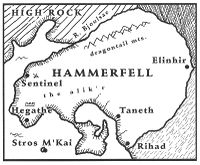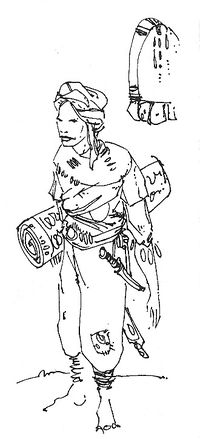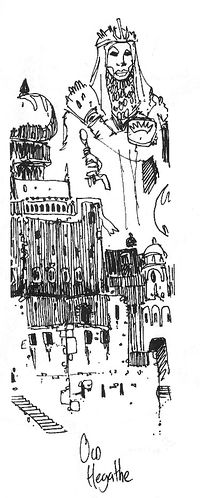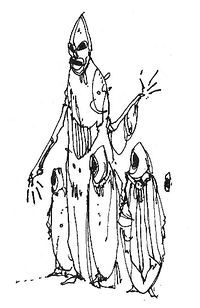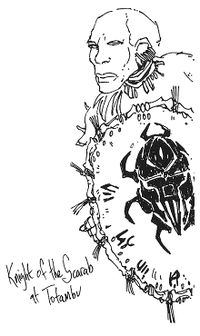Lore:Pocket Guide to the Empire, 1st Edition/Hammerfell
| HAMMERFELL |
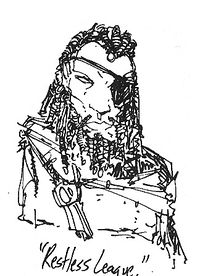
Hammerfell is the eternal outsider of the human lands, either regarded by the Imperial citizen as Tamriel's dark and exotic west or its most tempestuous and dangerous quarter, full of barbarians and cutthroats. Both descriptions are apt, and can be equally attributed to its people, the proud and savage Redguards.
Some three thousand years ago the continent of Yokuda suffered a cataclysm that sunk most of it into the sea, driving its people towards Tamriel. The bulk of these refugees landed at the uninhabited isle of Herne, while the rest continued on to the mainland. This vanguard "warrior wave" of Yokudans, the Ra Gada, swept into the country, quickly slaughtering and enslaving the beastfolk and Nedic villagers before them, bloodily paving the way for their people who waited at Herne, including the Na-Totambu, their kings and ruling bodies. The fierce Ra Gada became, phonetically, the Redguards, a name that has since spread to designate the Tamrielic-Yokudan race in general. They ultimately displaced the Nedic peoples, for their own agriculture and society was better organized and better adapted to Hammerfell's harsh environment. They took much of Nedic custom, religion, and language for themselves in the process, and eventual contact with the surrounding Breton tribes and Colovian Cyrodilics hastened their own assimilation into the larger Tamrielic theater. Yoku, the Redguard oral language, was almost entirely replaced as the need for foreign commerce and treaties increased.
Under the provincial organization of the Second Empire, two Redguard "parties" formed to aid Cyrodiil's administration of Hammerfell. The ancient Na-Totambu ruling class retained the rights of noble council as the Crowns, and the much-admired warriors of the Ra Gada were finally granted rights of ownership within their tribal districts. This empowerment fundamentally changed the Ra Gada, who began to call themselves the Forebears, firmly announcing their status as the first Redguards on Tamriel. This republic, however, lasted only so long as the Cyrodiils were strong enough to support it. During the Imperial Interregnum, control reverted back to the hereditary monarchy of the Na-Totambu. The new "High King" was even so bold as to move his throne from Old Hegathe to the more prosperous Forebear city of Sentinel, which had, by this time, mastered a third of the trade of the Iliac Bay.[YR 1]
Thassad II was the last of these "High Kings," for upon his death in CE862, the honorable Forebears retook Sentinel by force. Crown Prince A'tor then sailed from Stros M'kai to avenge his father, resulting in one of the bloodiest massacres of Tamrielic history. Tiber Septim, in his rightful duty as Heir to the Reman Dynasty, answered the Forebears' plea for help, sending his men to end the mad Prince's butchery. A'tor found it impossible to stand against the superiority of the Imperial legions-- many of the Crowns had deserted him after seeing the glory of the reborn Empire. He and a few loyalists fled back to Stros M'kai, doggedly pursued by the West Navy, where they were soundly defeated at the Battle of Hunding Bay. The Emperor, in his wisdom, deemed it best to assume responsibility for Hammerfell's lawful restoration as a republic and provincial territory, where presently the Redguards spend their days as proud subjects[YR 2] of the new Cyrodilic Empire.
Physically, the Redguards can be intimidating to an outsider, with their dark skin and wooly hair, tall, gaunt frames and finely toned physiques. Custom and dress differs by district: the Redguards of Elinhir are Colovian in fashion and taste, while some in Rihad go naked in the streets. In demeanor, they are haughty and easily provoked, and, to the last, obsessed with personal honor. Though it is widely acknowledged that Hammerfell is home to the finest warriors of the Empire, they are but indifferent soldiers, being unwilling to defer to authority or endure military discipline, and few serve in the Ruby ranks. There is no standing army in Hammerfell, only paid militias of the oft-contested border-states and along its coastline. Ancient tradition has predisposed the Redguards to knightly orders, though, customarily in the service of royal families. Initiates of these orders must prove themselves in dangerous, even deadly, tests of skill. The youths of Crown Totambu, for example, must sail to the Dwemer Ruins of Stros M'kai, to avoid its deathtraps and "wrestle its mechanical men back into shape" before they can join the Knights of the Scarab. The more severe Order of Diagna, on the other hand, stages an annual recreation of the Siege of Orsinium, where their initiates must play the part of the Orcs....
The colonization of Hammerfell was a slow process, since it was mainly a barren and rocky place, with the vast Alik'r desert in the center, and only a few grasslands that hugged the coastline in horseshoe fashion. As such, Redguard civilization is divided into the cosmopolitan coastal cities on one hand, and the numerous nomadic tribes that wander the desert itself on the other. The former have adopted Breton or Imperial manners of dress and architecture, modified with motifs and styles from lost Yokuda, and some have even reorganized their gods and tribal spirits to fit into the traditional Imperial pantheon of Eight Divines[YR 3]. The nomads are more primitive, either with trace-Nedic influences or stubbornly Yokudan, throwback castaways even to other Redguards. Devotees of Satakal the Serpent God are strewn among them, historically causing the A'likr border-states no end of strife. These revered madmen depend entirely on the charity of the other Redguards, though sometimes they rise in perilous bands, terrorizing the countryside in old Ra Gada fashion. Many, as in Rihad, go nude, rolling around in the dirt and nipping at the legs of passersby, "striking out" as if they were snakes themselves, while others perform terrible exhibitions of "shedding their skin". They have been seen rolling in the desert sand sidewinder-fashion in continuous, hundred-mile stretches, from Balhar all the way to the Nohotogrha oasis. The Satakals have never liked the Imperial presence, and have recently taken to harassing[YR 4] its civil servants. The Provisional Governors have been forced to run them out of the cities for the safety of its garrisoned troops and the native citizenry at large.
Tourists have, historically, given wide berth to the Redguard cities outside of those facing the Iliac Bay. Considering the (mostly deserved) reputation of its people, Hammerfell is frequently seen as intolerant of "foreigners," where trespass is dealt with in blood. This is a shame, and a situation that the Emperor seeks to rectify, for Hammerfell itself is a beautiful country. From the twin moonrises over the Alik'r shade-temples to the austere ramparts of Old Hegathe, everywhere there is the appearance of antique splendor. Its people are harsh-- four hundred years of internal conflict and corrupt government have made them so-- but, taken singly, the Redguard is often a masterful work of a man. Perhaps a guiding power like the Empire, steering Hammerfell clear of the foul agents of A'tor's legacy, and protecting her from the avarice of her Elven neighbors[YR 5], will bring the same prosperity to her people that it seeks to bring to the world.
Places of Note:
- Sentinel
- Second capital of Hammerfell, Sentinel sits on the edge of the Iliac Bay. It is most definitely a merchant power, for it sits on a rocky run of hills, and the barren plains behind it offer no good soil before they run into the desert sands of the Alik'r. Its principal street is a vast marketplace stretching from the harbor all the way to the badlands gate. Sentinel Palace is the oldest and largest Redguard architectural monument, quickly built during the Ra Gada firestorm to ward against the Bretons and added to ever thereafter. Currently, this Palace is the headquarters of Provisional Governor Senecus Goddkey, who has been helping to administer the Forebear principalities since Baron Volag's disappearance[YR 6]. Since its Imperial reorganization, Sentinel has become an exotic retreat for the nobility of Daggerfall and Wayrest, who delight in its native cooking, craftsmanship, and the bizarre morality-plays of its Royal Theatre.
- Stros M'kai
- Formerly the principality of Thassad II's heir, A'tor, Stros M'kai's small island serves as the office of Provisional Governor Amiel Richton, who is charged with the protection and patrol of Hammerfell's barbarous southern coast. Lord-Admiral Richton[YR 7] was the officer who defeated Prince A'tor in the Battle of Hunding Bay, and is the latest of a long line of heroes to serve in the Colovian West Navy. Stros M'kai itself would be an unassuming little port, famous only for its Dwemer Ruins, were it not for its presently strategic location near the Cape of the Blue Divide, the waters of the dread Aldmeri Dominion.
|
- Annotations left by "YR", an elven traveler sending this pamphlet to his uncle, are as follows:
